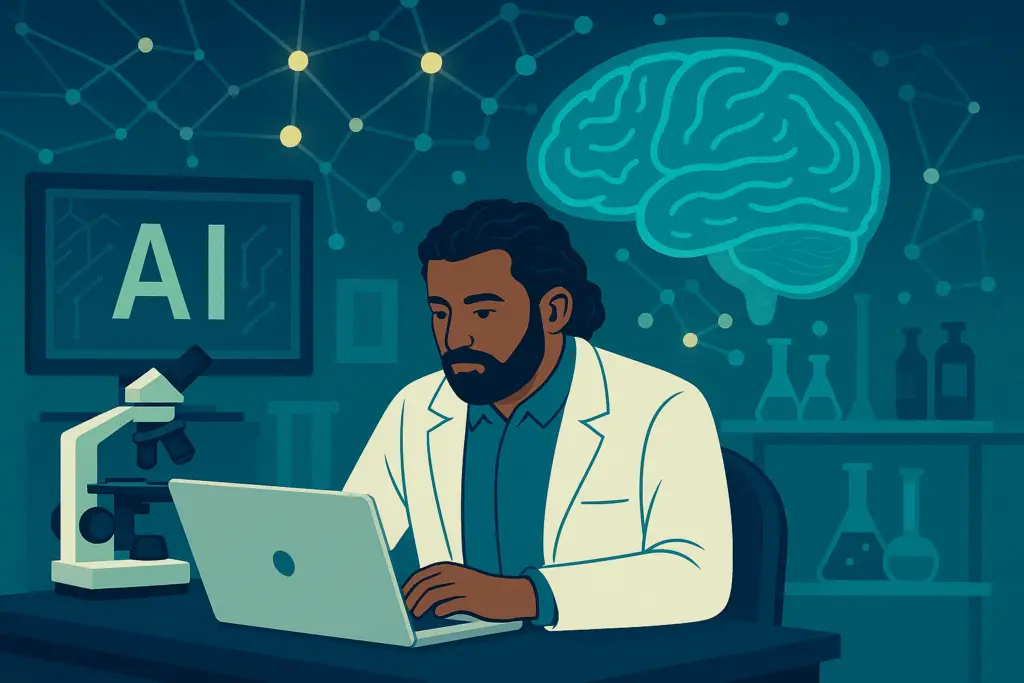AI in Scientific Research: Why It’s a Tool, Not a Savior
By Amrapali · April 2025

AI in Scientific Research
We’ve all seen the headlines- “AI Will Revolutionize Scientific Research” or “AI: The Future of Medicine, Physics, and Everything in Between.” It’s true that AI has made massive strides in the way we conduct research, process data, and make predictions. But, let’s be honest for a second—there’s a growing myth out there that AI in scientific research is some kind of magical, all-knowing savior for the scientific world. And I am here to call that out.
As a researcher myself, I’ve seen firsthand the impact AI has had in streamlining certain processes—especially when it comes to sifting through data and uncovering patterns. But, here’s the thing: AI is a tool. A very powerful tool, sure. But it’s not a miracle worker. It’s not going to suddenly answer all the big questions in science. Infact, it can’t even begin to ask the right questions by itself.
Let me explain why.
A more realistic view of AI in scientific research helps us understand both its power and its blind spots. Don’t get me wrong – AI has definitely earned its place in scientific research, but here is the catch – AI is only as good as the data you feed it, and it lacks the creativity and insight that researchers bring to the table.
Why AI in Scientific Research Still Needs the Human Touch
Take genomics, for example. AI can analyze millions of gene sequences in a fraction of the time it would take a human to do it manually. It’s incredible, really. But, and this is a big but, AI is only identifying patterns in the data. It doesn’t understand the context or the nuances that a trained researcher would bring to the table. AI can’t tell us why those patterns exist, or what they mean in the broader context of biology or disease.
While AI can help speed up data analysis, automate tasks, and even predict certain outcomes based on the patterns it identifies, at the end of the day, it’s the researcher’s role to ask the right questions, interpret the data with respect to the context, and drive discovery. AI might tell you that a protein is a misfit, but it won’t know why it’s happening, or what experiment should be designed to fix it. That’s up to us.
Here’s another thing that often gets overlooked in the AI hype: its limitations. AI is powerful, but it’s dependent on high-quality data. If the data is flawed, biased, or incomplete, the results will be too. AI isn’t infallible—it’s only as good as the data we give it. And let’s not forget the “black box” problem, where AI can produce results without explaining how it reached those conclusions.
The Limitations of AI: It’s All About the Data
AI can’t think outside the box or generate new ideas. It can’t design experiments or come up with novel hypotheses. That’s where human researchers come in, using intuition, creativity, and deep understanding of the subject to ask new questions and explore answers that AI wouldn’t conceive of.
Let’s not get carried away, though. AI has undeniably made an impact in research. In drug discovery, for example, AI has helped analyze molecules, predict their effectiveness, and suggest new drug candidates, saving time and resources. AI also aids in predicting outcomes, like how a virus might mutate or patterns in cancer progression. But there’s no AI without researchers. The human element is essential to interpreting findings, testing hypotheses, and applying them in real-world scenarios. While AI can offer valuable insights, it’s up to researchers to contextualize those findings, design follow-up experiments, and apply them meaningfully.
This is one of the biggest limitations of AI in scientific research – it doesn’t grasp context the way humans do. While AI tools in research can save time and crunch massive datasets, they don’t replace human interpretation.
<!– Ad Placeholder –>
<div class=”ad-space” style=”display: none;”>[Ad will go here]</div>
The Hot Take
Here’s the takeaway: AI in science is a tool, not a savior. It can amplify our work, speed up discoveries, and make our processes more efficient, but it’s not going to replace researchers. It doesn’t bring creativity or insight to the table. It can help analyze data, run simulations, and spot patterns, but we still need to drive research forward, ask the tough questions, and develop new ideas.
In short, AI is a fantastic assistant, but it’s not the scientist.
So let’s stop pretending AI is the magic bullet that will solve all our problems. It’s not. But when used correctly, it can definitely be an asset that helps us get closer to the answers. At the end of the day, AI vs human researchers isn’t a battle — it’s a partnership. But one side still asks the better questions.
Agree or disagree? Drop your thoughts in the comments—let’s keep this conversation going!
For more such takes click here.
<!– Ad Placeholder –>
<div class=”ad-space” style=”display: none;”>[Ad will go here]</div>

